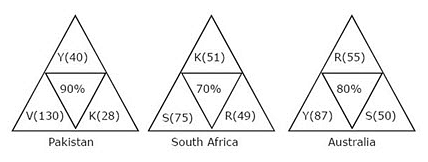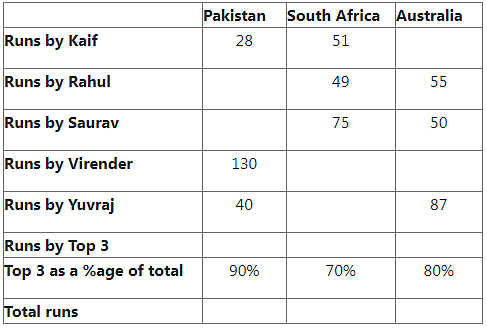In Logical Reasoning very often we encounter problems based on games and tournaments. The first thing that as a CAT taker you need to realize is that such tournament based format offers the examiner a multitude of options. So, there cannot be a set formula for solving such kind of questions. However, if you look at the CAT papers of past few years – a pattern seems to emerge.
Type 1
The questions are typically in a set where the data will be either in the standard tabular format or a format which you would never find on Cricinfo or for that matter any other ESPN website. The ‘different for the sake of being different’ format essentially tests a CAT taker’s ability to infer data in newer formats.
An example of this would be:
Each diagram communicates the number of runs scored by the three top scores from India, where K, R, S, V, and Y represent Kaif, Rahul, Saurav, Virender, and Yuvraj respectively. The % in each diagram denotes the percentage of total score that was scored by the top three Indian scorers in that game. I will not get into the detail of solving this particular set. Once you interpret the information, the questions are really simple. The catch in this question (this type of questions) is to interpret the given data.
I will not get into the detail of solving this particular set. Once you interpret the information, the questions are really simple. The catch in this question (this type of questions) is to interpret the given data.
Let us look at this information in a different way:
As you can see, the triangular format is no different from providing the same information to the student in a table. It is just a little more intimidating in a pressure situation – and that intimidation is exactly what you should avoid. With some very simple addition and calculation you will be solve this problem set.
Bottom line
Even if it takes a couple of minutes, it is best to represent information in a format that you are comfortable with.
Type 2
For some reason, Tennis appears to be a favorite among exam setters. Actually Tennis does offer some very interesting possibilities – such as seeds, an unconventional scoring and the knockout feature. Knockouts are inherent in the sport of Tennis and hence used frequently by exam setters.
Note: In a knockout tournament,
No. of matches = No. of players – 1
Let us look at few ideas related to questions on seeded players. Let’s say in a tournament there are ‘n’ players and they are seeded (ranked) from 1 to n. Typically this ‘n’ is a power of 2 like 32 or 64 or 128.
In the first round the highest seeded player plays the lowest seeded player, the second highest seeded player plays the second lowest seeded player and so on. To put it into perspective:
- Round 1 – Match 1 – Seed 1 Vs Seed n
- Round 1 – Match 2 – Seed 2 Vs Seed (n-1)
- Round 1 – Match 3 – Seed 3 Vs Seed (n-2)
Round 1 – Match n/2 – Seed n/2 Vs Seed n/2 + 1
In the second round, winner of Match 1 plays winner of Match n/2; winner of Match 2 plays winner of Match n/2 – 1 and so on.
In this kind of questions, an ‘upset’ comes into the picture which essentially means that a lower seeded plays beat a higher seeded player.
The questions are typically of the format
Q1: Who will play match 36 in Round 1?
Ans: It will be played between the 36th highest seed and the 36th lowest seed.
The 36th lowest seed can be sometimes difficult to figure out but you can figure it out easily by calculating (n+1) – 36.
Note: The rth match in Round 1 will be played between Seed ‘r’ and Seed ‘n+1-r’
Q2: If there are no upsets, then in Round 2 who will play the 5th match?
Ans: One way of solving this question would be figuring out the winners of Round 1 and then figuring out the 5th from the top and the bottom.
If there is no upset, then seed 5 will be there. The other player would be (n/2+1 – 5)
Note: If there are no upsets, then the rth match in the pth round will be played between –
Seed ‘r’ and Seed
Q3: Who will meet Seed 37 in the Quarterfinals of a tournament in which 64 players are taking part?
Ans: Other than Seed 37’s matches, there were no other upsets.
We first need to analyze which round would be the quarterfinal:
Round 1 (32 matches), Round 2 (16 matches), Round 3 (8 matches – pre-quarter), Round 4 (4 matches – quarterfinals).
In Round 1, Seed 37 must have defeated 64 + 1 – 37 = 28
In Round 2, Seed 37 played the match that Seed 28 would have played. Seed 28 would have played against Seed 32 + 1 – 28 = Seed 5
In Round 3 (pre-quarters), Seed 37 played the match that Seed 5 would have played. Seed 5 would have played against Seed 16 + 1 – 5 = Seed 12 and won it.
In Round 4 (quarterfinals), Seed 37 would meet the player that Seed 5 would have met. Seed 5 would have met 8+1-5 = 4.
Hence, Seed 37 will meet Seed 4 in the quarterfinals.
As a matter of fact, even the above solution is not the most optimal one. Because once you realize that Seed 37 defeated Seed 5, he would keep meeting the opponents that Seed 5 would have met.
FAQs on Overview: Games and Tournaments - CAT
| 1. What are Games and Tournaments CAT? |  |
| 2. How do Games and Tournaments CAT work? |  |
| 3. What is the eligibility criteria for Games and Tournaments CAT? |  |
| 4. How can I prepare for Games and Tournaments CAT? |  |
| 5. How is the Games and Tournaments CAT score used in the admission process? |  |


















